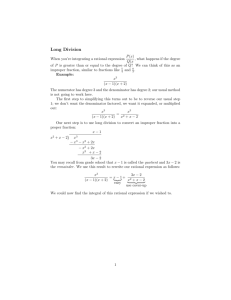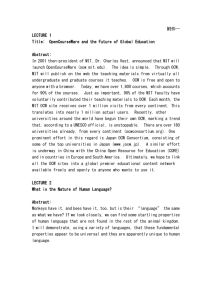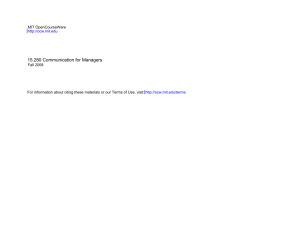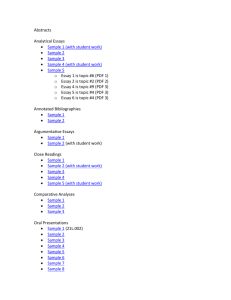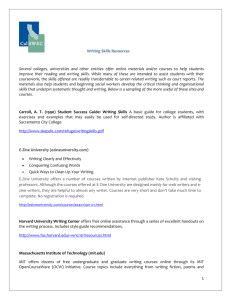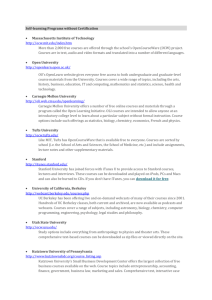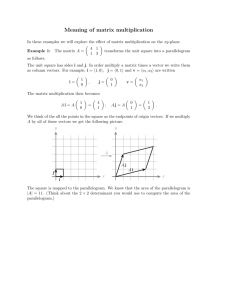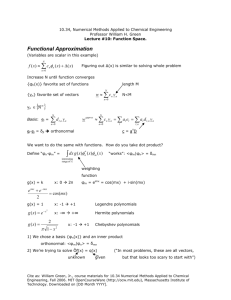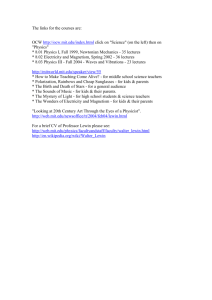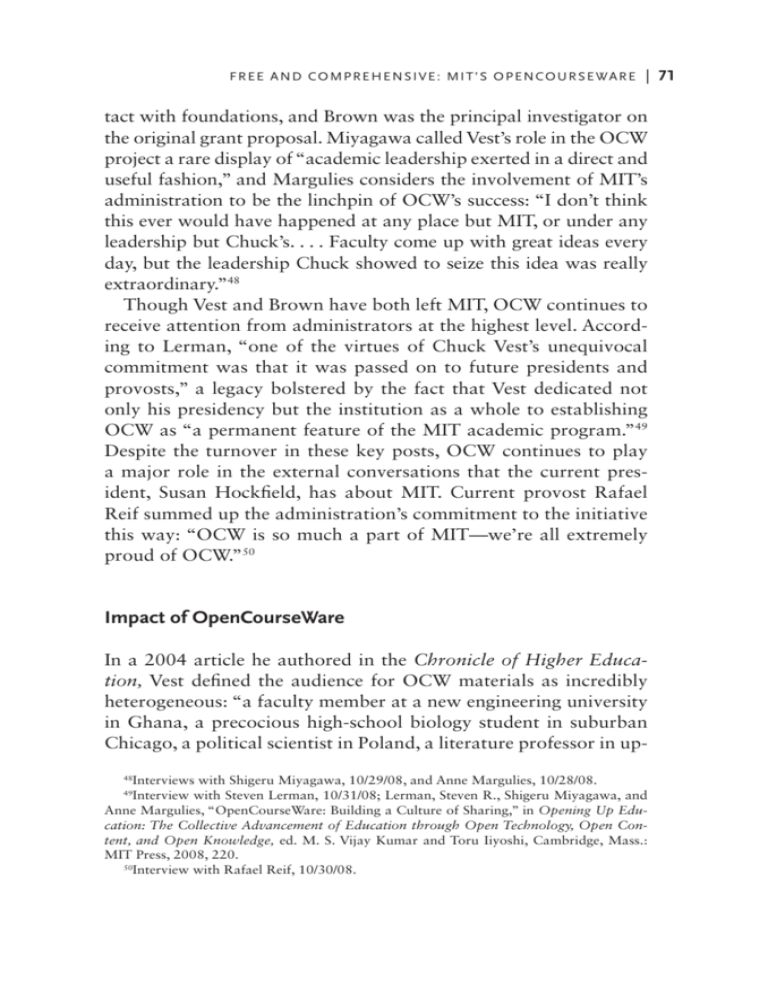
F R EE A N D COM PR EHEN S IV E: M I T ’S O P E N C O URS E W A RE
| 71
tact with foundations, and Brown was the principal investigator on
the original grant proposal. Miyagawa called Vest’s role in the OCW
project a rare display of “academic leadership exerted in a direct and
useful fashion,” and Margulies considers the involvement of MIT’s
administration to be the linchpin of OCW’s success: “I don’t think
this ever would have happened at any place but MIT, or under any
leadership but Chuck’s. . . . Faculty come up with great ideas every
day, but the leadership Chuck showed to seize this idea was really
extraordinary.”48
Though Vest and Brown have both left MIT, OCW continues to
receive attention from administrators at the highest level. According to Lerman, “one of the virtues of Chuck Vest’s unequivocal
commitment was that it was passed on to future presidents and
provosts,” a legacy bolstered by the fact that Vest dedicated not
only his presidency but the institution as a whole to establishing
OCW as “a permanent feature of the MIT academic program.”49
Despite the turnover in these key posts, OCW continues to play
a major role in the external conversations that the current president, Susan Hockfield, has about MIT. Current provost Rafael
Reif summed up the administration’s commitment to the initiative
this way: “OCW is so much a part of MIT—we’re all extremely
proud of OCW.”50
Impact of OpenCourseWare
In a 2004 article he authored in the Chronicle of Higher Education, Vest defined the audience for OCW materials as incredibly
heterogeneous: “a faculty member at a new engineering university
in Ghana, a precocious high-school biology student in suburban
Chicago, a political scientist in Poland, a literature professor in upInterviews with Shigeru Miyagawa, 10/29/08, and Anne Margulies, 10/28/08.
Interview with Steven Lerman, 10/31/08; Lerman, Steven R., Shigeru Miyagawa, and
Anne Margulies, “OpenCourseWare: Building a Culture of Sharing,” in Opening Up Education: The Collective Advancement of Education through Open Technology, Open Content, and Open Knowledge, ed. M. S. Vijay Kumar and Toru Iiyoshi, Cambridge, Mass.:
MIT Press, 2008, 220.
50
Interview with Rafael Reif, 10/30/08.
48
49
72 |
CHAP TER 3
state New York, or an executive in a management seminar down
the hall at MIT will be able to use the materials our professors rely
on in teaching our full-time students.”51 But Margulies and Vest
both said that the audience originally envisioned for OCW was
primarily other educators, and that the OCW team was surprised
to eventually learn that more “self-learners” were using the materials than teachers.52
There has always been an emphasis on the developing world as
a key audience for OCW. The first grant proposal states that “we
expect OCW to be of particular value in developing countries that
are trying to expand their higher education systems rapidly. . . .
The OCW materials will be able to jump-start curriculum improvements in these countries.”53 Lerman echoed this sentiment in
the press conference announcing OCW, saying “we hope our materials will be translated. Developing countries need information,
and they need to develop infrastructure and institutions.”54
The main appeal of OCW rests on the premise that these course
materials will be useful to individuals around the world. But the
OCW staff admits that much of the site may not be suitable for
the average learner. According to Margulies, “the material starts
with the assumption that you have to be an MIT-caliber student to
be able to use [it]; it’s not at all for your average student.”55 When
asked if the site’s current offerings are geared toward any specific
group, Carson responded that “in going for breadth, I think we
probably skewed to the side of educators by covering the entire
curriculum. The bare bones version of a course is only going to be
useful to educators and educational administrators who are developing curricula. . . . But you need a relatively deep amount of
51
Vest, Charles M., “Why MIT Decided to Give Away All Its Course Materials via the
Internet,” Chronicle of Higher Education, online edition, January 30, 2004.
52
MIT OpenCourseWare, “2005 Program Evaluation Findings Report,” June 5, 2006,
http://ocw.mit.edu/ans7870/global/05_Prog_Eval_Report_Final.pdf, 11.
53
“MIT OpenCourseWare: A Proposal,” 14.
54
“MIT to Make Nearly All Course Materials Available Free on the World Wide Web,”
press release, MIT News, April 4, 2001. OCW materials have subsequently been translated
into more than ten languages, through formal translation partnerships or independent efforts.
55
Interview with Anne Margulies, 10/28/08.
F R EE A N D COM PR EHEN S IV E: M I T ’S O P E N C O URS E W A RE
| 73
content in a course for independent learners to make use of it,” and
many of the OCW versions lack that necessary depth.56
From the beginning, OCW did not plan to offer users any kind of
interaction with MIT professors or graduate students, avoiding the
asynchronous threaded discussion or live chats that characterized
Fathom and AllLearn courses.57 On the one hand, this limited the
scope of the project in a way that allowed the OCW team to stay
focused on its publishing mission and minimize distractions—and
in a university full of people with personal and professional interests in technology, OCW has not allowed itself to become bogged
down in unnecessary technological complexities.58 But on the other
hand, the lack of interactive features on OCW has also necessarily
limited its impact: as Vest himself said in his first press conference
on OCW, “real education requires interaction, the interaction that
is part of American teaching.”59
From the beginning, MIT has felt an obligation to undertake selfevaluation efforts to track its user demographics along with levels
and patterns of usage. But understanding usage scenarios for freely
available online content has often proved quite challenging. Mar56
Interview with Steve Carson, 10/27/08. “I would say about a third of our courses are
primarily useful only to educators. Another third are useful to both educators and students,
and then there’s a final third of our courses that really support independent learning in a
significant way.”
57
From the perspectives of some of the AllLearn team, MIT’s format was a step backward, as they considered interaction a key source of value for AllLearn. In a Yale Daily
News article covering the launch of OCW, Yale President Richard Levin discussed the difference between MIT’s plans and those of the Alliance, saying “We would use the Internet
to create online discussions, and our thinking is much more interactive. The MIT approach
is just making it available to anyone who wants it” (quoted in Ladine, Bret, “MIT to Offer
Access to Materials Online,” Yale Daily News, online edition, April 5, 2001). Stanford Provost John Etchemendy agreed, saying that in MIT’s case, “Putting course materials online is
really just a step beyond what universities have always done,” resulting in what he saw as
less innovative offerings than AllLearn’s (interview with John Etchemendy, 8/19/08).
58
The majority of the course content is delivered in PDF files, and the “back-end” technology is also simple and straightforward, built using off-the-shelf commercial software
products (although Margulies said that Microsoft donated substantial resources to customizing their back-end software). The fact that OCW did not use open-source technology
drew some criticism, but Margulies defends it as an expedient business decision—evidence
of the professionalized, deadline-driven working environment surrounding OCW’s production process (interview with Anne Margulies, 10/28/08).
59
“MIT to Make Nearly All Course Materials Available.”
74 |
CHAP TER 3
gulies said that “when we got grant funding, we knew we were going to have to have measurable results to report,” but “figuring out
how to measure and evaluate results was hugely difficult.”60 OCW
first approached outsiders to investigate usage by issuing a request
for user studies proposals, but after a series of unsuccessful partnerships, concluded that they would be better off conducting the
research themselves.61 To date, that research has centered mostly
on gathering demographic information through surveys and web
analytics, as well as employing survey methodologies to understand the uses to which the OCW content is put.
The original grant proposal states that concerning “the usage levels of OCW, we have not yet established clear, quantitative goals,”
and the organization never developed a specific number of users
they wanted to reach with the material.62 An evaluation conducted
in 2009 revealed that users were geographically dispersed, with 54
percent of visits originating from outside the United States. The
report also broke down users by type, with 43 percent identifying
themselves as self-learners, 42 percent as students, and 9 percent
as educators.63 As of July 2010, the OCW website claimed the site
has received “100 million visits by 71 million visitors from virtually every country” since its launch, averaging 1 million visits per
month.64
When it comes to the effect that OCW has had outside of the
MIT community, OCW’s proponents are confident that their work
has been meaningful worldwide, though the specifics or the scale
Interview with Anne Margulies, 10/28/08. D’Oliveira agreed, saying “you’ve got to
prove to your funders what they’re getting, and the more money you’re getting from them,
the more imperative that evaluation is” (interview with Cecilia d’Oliveira, 10/29/08).
61
Interview with Anne Margulies, 10/28/08. According to Margulies, the various interested parties were concerned more with using OCW to conduct academic research than with
answering the questions about user behaviors that were important to MIT.
62
“MIT OpenCourseWare: A Proposal,” 15.
63
MIT OpenCourseWare, “2009 Program Evaluation Findings Summary,” http://ocw.mit
.edu/ans7870/global/09_Eval_Summary.pdf.
64
MIT OpenCourseWare, “About OCW: Site Statistics,” http://ocw.mit.edu/about/
site-statistics/. In a 2008 publication, Lerman, Miyagawa, and Margulies wrote that “in addition, there are over 100 mirror sites in Africa and Asia that deliver MIT content to users
who have limited Internet access. And users have downloaded complete course packages for
off-line use over several million times” (Lerman, Miyagawa, and Margulies, “OpenCourseWare: Building a Culture of Sharing,” 216).
60
F R EE A N D COM PR EHEN S IV E: M I T ’S O P E N C O URS E W A RE
| 75
of that impact is difficult to determine. While internal benefits to
MIT may have been an acknowledged consequence of the OCW
project from the beginning, the external impact was always viewed
as paramount. Vest wrote in 2004 that “the real pay-off of what we
hope will become the open-courseware movement will be its effect
on educators and learners around the world.”65 The language of
the original grant proposal’s sections dealing with impact reveals
both MIT’s vast ambitions for OCW’s effects on the wider world
and a lack of clear metrics for systematically assessing that impact.
The proposal’s authors state that “we believe that in the long run,
OCW, like other successful contributions to education, will lead to
greater equality and improvements in economic performance, but
these long-term, ultimate outcomes are impossible to isolate and
measure.”66
Though web analytics can give the OCW team a sense of the traffic levels their site is receiving, whether or not OCW has actually
made a difference in teaching, learning, or the state of global education is a more complicated issue. Margulies said that OCW has
always known that it was important to collect data on impact—not
only on who was using the materials and how, but also on whether
the site was actually creating meaningful change in individual lives
or institutions—but that the team knew that it would take time to
develop a methodology for that sort of inquiry. “Because our audience is the world, it’s not like we could measure test scores or worldwide educational achievement, or even the achievement of our users.
With OpenCourseWare, we couldn’t have a control group, so our
impact data is still somewhat anecdotal.”67
When assessing its global impact to date, OCW has relied heavily on the voluminous—yet unscientific—feedback it has received.68
The tens of thousands of overwhelmingly positive emails that users
Vest, “Why MIT Decided.”
“MIT OpenCourseWare: A Proposal,” 15.
67
Interview with Anne Margulies, 10/28/08.
68
As Vest stated in 2004, “since we announced OCW, we have received more than
13,000 e-mail messages from around the world endorsing our vision and the potential benefits of sharing knowledge freely” (Vest, “Why MIT Decided”). D’Oliveira said that OCW’s
“impact may not be scientifically provable, but we love getting the anecdotal feedback on
a daily basis from people who tell their stories. There aren’t many jobs I’ve had where you
65
66
76 |
CHAP TER 3
have sent to OCW since its launch have convinced MIT that it
has created something of true value. “I think it’s had—in some
cases—a genuinely transformative and profound impact on lots
and lots of individuals who have used it either to dramatically
improve their teaching or to advance their learning,” Margulies
said. “The accumulated over-the-top feedback that we get convinces me that it’s been enormously positive.”69 User surveys have
tried to generate some data on impact, and a detailed Program
Evaluation Findings Report conducted in 2005 found that “80
percent of visitors rate OCW’s impact as extremely positive or
positive; 91 percent expect that level of future impact.” The report also states that “visitor intent to return to the site is a strong
indicator of perceived impact . . . 76 percent of first time visitors
and 88 percent of returning visitors indicate that they will definitely return to the site.”70 But the method of surveying visitors
to the website who have volunteered to complete questionnaires
necessarily limits respondents to a self-selected portion of the
user population and excludes nonusers altogether.71 While OCW
has received positive feedback on all of the indicators of impact
it has established, it has nothing to benchmark this level of usage
and these reactions against—no way to evaluate if positive feelings translate into an impact commensurate with MIT’s hopes for
the program.
Immediately following the program’s launch, community expectations for OCW’s impact were sky-high. In his 2001 President’s
Report, Vest said that “the reaction to its announcement has been
astounding. Some have likened it to the Gutenberg printing press
and to the Great Library at Alexandria. This is a bit hyperbolic
get that many continual insights into the results of your work” (interview with Cecelia
d’Oliveira, 10/29/08).
69
Interview with Anne Margulies, 10/28/08.
70
MIT OpenCourseWare, “2005 Program Evaluation Findings Report,” 4, 62.
71
Education scholar Diane Harley’s research has emphasized this problem, and she notes
that “both online surveys and TLA (transaction log analysis) are prone to overlook the universe
of non-users. An understanding of non-users and their motivations can be extremely valuable
for planning and development” (Harley, Diane, and Jonathan Henke, “Toward an Effective
Understanding ofWebsite Users,”D-Lib Magazine 13,no.3–4 [March–April 2007],http://www
.dlib.org/dlib/march07/harley/03harley.html).
F R EE A N D COM PR EHEN S IV E: M I T ’S O P E N C O URS E W A RE
| 77
for my taste, but even as clear-eyed an observer as IBM’s CEO,
Lou Gerstner, recently stated to Wall Street analysts: ‘What do you
think happened when MIT put its entire course catalog on the
Net, for free? If that didn’t send a shiver through the higher education system in the world, I don’t know what will.’ ”72 But several years into the project, interpretations vary as to whether these
early ambitions for OCW have yet been realized. A 2007 report to
the Hewlett Foundation reviewing its investments in Open Educational Resources calls OCW a “world-changing project.”73 But Ira
Fuchs of the Mellon Foundation takes a more tempered view. Although he credits the OCW concept with great potential for future
transformative impact, in assessing the project’s system-wide impact to date he said that “if you take away OCW completely, I’m
not sure that higher education would be noticeably different.”74 A
decade after OCW’s launch, it is too early to determine whether
the idea will fundamentally alter the way that universities disseminate knowledge—and if so, how.
More concretely, MIT OCW has served as a model for course
dissemination efforts at other institutions, spurring the creation of
over 200 similar projects at universities around the world (though
it is important to note that some similar open projects, such as Rice
University’s Connexions or webcast.berkeley, profiled in Chapter
6, had quietly begun prior to OCW). From very early in OCW’s
history, its proponents have sought not only to publish MIT’s catalogue of course materials but also to encourage other institutions
to do the same. At the press conference announcing OCW, Vest
said that “this is about something bigger than MIT. . . . We would
be delighted if—over time—we have a world wide web of knowledge
that raises the quality of learning—and ultimately, the quality of
life—around the globe.”75 As suggested, success for the initiative in
72
Vest, Charles M., “Disturbing the Educational Universe: Universities in the Digital Age
—Dinosaurs or Prometheans?” Report of the President for the Academic Year 2000–01, http://
web.mit.edu/president/communications/rpt00-01.html.
73
Atkins, Daniel E., John Seely Brown, and Allen L. Hammond, “A Review of the Open
Educational Resources (OER) Movement: Achievements, Challenges, and New Opportunities,” report to the William and Flora Hewlett Foundation, February 2007, 8.
74
Interview with Ira Fuchs, 12/2/08.
75
“MIT to Make Nearly All Course Materials Available.”
78 |
CHAP TER 3
the eyes of its founders hinged on both creating the OCW product
and serving as a model for others to emulate.76
The OpenCourseWare Consortium (OCWC), launched in 2005
with a planning grant from the Hewlett Foundation, represents
OCW’s efforts to turn an idea into a movement. OCW began
fielding requests from other universities—with early interlocutors including the Johns Hopkins University, Tufts University, and
Utah State University—to tell its story and describe its processes.
In OCW’s early years, this outreach function was managed at a
personal level by the project’s leadership, but Carson explained
that by 2005 the conversations involved so many outside participants that they were becoming unwieldy.77According to Margulies,
“as we started to help people do what we were doing, a natural
next step was to formalize it and organize ourselves.”78 Following an initial planning meeting in February 2005, the Consortium
had its first official meeting that September and established three
objectives for itself: to “extend the reach and impact of OpenCourseWare by encouraging the adoption and adaptation of open
educational materials around the world,” “foster the development
of additional OpenCourseWare projects,” and “ensure the longterm sustainability of OpenCourseWare projects by identifying
ways to improve effectiveness and reduce costs.”79
Until recently, the Consortium was basically run as a subsidiary of MIT. The OCWC’s first director, John Dehlin, was hired
in 2006 as an MIT employee reporting to Carson, and grant funding from Hewlett was awarded to MIT on the Consortium’s be76
Abelson said that while sparking worldwide interest in the creation of OCW was
included in the first grant proposal as one of OCW’s original intended outcomes, “the
Hewlett Foundation gave specific funding for more aggressive action in the community,”
so in later phases OCW went further in that direction using grant money allocated for that
purpose (interview with Hal Abelson, 10/31/08).
77
Carson said that once the level of interest hit a tipping point, “we decided to bring
everybody together to talk about the idea of forming a consortium, and that way we’re
creating channels for Tufts to talk to Johns Hopkins to talk to Utah State, because they’re
facing different challenges than we were, because we had a lot more money to throw at our
problems than they had to throw at theirs” (interview with Steve Carson, 10/27/08).
78
Interview with Anne Margulies, 10/28/08.
79
Carson, Steve, “The Unwalled Garden: Growth of the OpenCourseWare Consortium,
2001–2008,” Open Learning: The Journal of Open and Distance Learning, online edition,
24, no. 1 (February 2009).
F R EE A N D COM PR EHEN S IV E: M I T ’S O P E N C O URS E W A RE
| 79
half, giving MIT final authority over how it was to be spent.80 In
July 2008, the Consortium was incorporated as a 501(c)(3) organization independent of MIT (a structure that allows it to manage its own finances), and its leadership has shifted to a governing
board composed of representatives from various member institutions, with Carson serving as its chair.
The Consortium currently includes several hundred institutions
of higher education, with its most robust growth coming from nonEnglish-speaking regions, particularly Asia. But elite U.S. institutions have not been particularly receptive to the OCW concept.
Margulies said that when she and Provost Brown first discussed
OCW’s potential to inspire similar projects, they had assumed that
public institutions in the United States would be early adopters.
“Instead, we found that people got more excited about OpenCourseWare the farther you got from Cambridge—it was people from the
other side of the world who really embraced the concept.”81 Carson agreed, suggesting that MIT’s involvement with the Consortium has been “both a blessing and a curse”: he believes that the
MIT name has been a draw for some, while others have resisted
joining for fear of appearing to be following MIT.82 Time will tell
in which direction the Consortium ultimately develops, but to date
OCW’s original vision of fellow American universities joining in
droves has not been fulfilled.
The OCW project has been carried out in a coordinated and centrally planned manner, and now that OCW has become an established entity, the initiative may be evolving into a more prominent
strategic element for MIT as an institution. Assessing OCW’s internal value to the Institute, Carson said, “I think it started out as a
strategic approach toward positioning MIT in the online world, but
it’s proved to be a tool that’s useful in a great many other ways.”83
Interview with Steve Carson, 10/27/08.
Interview with Anne Margulies, 10/28/08.
82
Interview with Steve Carson, 10/27/08. While some elite U.S. institutions involved in
online open courseware projects, such as the Johns Hopkins University and the University
of Notre Dame, have joined the Consortium, others, like Carnegie Mellon and Yale, have
not. Vest, Carson, and Margulies attribute those universities’ decisions to a sense of competitiveness that makes them reluctant to appear to be in MIT’s shadow.
83
Interview with Steve Carson, 10/27/08.
80
81
80 |
CHAP TER 3
Indeed, some of the “other ways” in which OCW could benefit
the MIT community were present in its founders’ minds early on,
and they have taken on greater importance in recent years. Margulies said that the OCW team may have initially “underestimated”
the benefits that the project would have for MIT, although “it’s not
as if they didn’t have an inkling . . . that it would have a subtle and
secondary beneficial impact on improving the educational materials
at MIT, and therefore MIT students would benefit.”84 Brown and
Abelson confirmed that the potential internal impacts of OCW were
an important early component of the project and were especially
valuable in convincing faculty to participate. Brown said that “when
we went to sell it internally, it wasn’t about doing something philanthropic or noble for the world, as much as transforming educational
content internally.”85 Abelson agreed that planners felt they had to
demonstrate to faculty that their own students would benefit from
their participation in OCW. When first discussing the OCW concept
with faculty, “the thing we had to fight was the notion that we were
doing this for altruistic reasons. . . . We had to explain how [OCW]
would give MIT a view of itself,” Abelson said.86
Many contend that OCW has positively affected teaching and
learning at MIT. As Brown put it, the presence of a course’s written
materials on OCW “pushes the faculty in the direction of ‘How do
I best use the contact hours so that people learn?’ which is clearly
critical.”87 The 2005 survey showed that many professors felt that
contributing to OCW improves their teaching: of the MIT faculty
surveyed, 32 percent agreed that contributing to OCW “improves
their teaching materials.”88 Margulies suggested that the reason for
this could be that faculty pay more attention to the quality of their
course content when they know those materials will be shared
with a world audience.89 OCW has also permitted faculty to look
closely at colleagues’ teaching materials and to identify gaps beInterview with Anne Margulies, 10/28/08.
Interview with Robert Brown, 10/27/08.
86
Interview with Hal Abelson, 10/31/08.
87
Quoted in Goldberg, “Auditing Classes at M.I.T.”
88
MIT OpenCourseWare, “2005 Program Evaluation Findings Report,” 4.
89
Interview with Anne Margulies, 10/28/08.
84
85
F R EE A N D COM PR EHEN S IV E: M I T ’S O P E N C O URS E W A RE
| 81
tween concepts covered in lower- and upper-level courses, evaluating the curriculum as a whole perhaps for the first time. Lerman
said that a comprehensive publication like OCW has been somewhat of a uniting force for the MIT faculty: “OCW is one of the
few things that all the faculty do together. I couldn’t get 5 or 10
percent of them to come to a faculty meeting, yet 90 percent of
them have licensed their materials to OCW.”90
OCW also receives significant use on MIT’s campus and has
generated positive feedback from students.91 The 2005 Program
Evaluation Findings Report states that “in all semesters for which
the OCW site was available, the heaviest use from the MIT domain
coincides with registration week,” suggesting that MIT students are
using it as an “enhanced course catalogue” when selecting their
classes. “Additional traffic spikes occur during mid-term and finals
weeks, suggesting use of the site by students in preparation for
examinations.”92 OCW also benefits the Institute by preserving
teaching materials.93
In response to OCW, MIT has received a great deal of positive
—even glowing—attention from the press, due in no small part to
the novelty of the open courseware concept when the project
launched.94 Some of OCW’s press coverage emphasized the Institute’s first-mover advantage. For instance, a 2003 article in Wired
magazine definitively states that prior to MIT’s launch of OCW,
“no institution of higher learning had ever proposed anything as
revolutionary, or as daunting,” and that with OCW, “MIT earned
Interview with Steven Lerman, 10/31/08.
In his 2007 article, Abelson wrote that “of 600,000 monthly visits to the MIT OCW
web site in September 2006, 25,000 originated from within MIT itself, a substantial number,
considering that there are only about 13,000 students and faculty at MIT, and only 23,000
MIT network users in total” (Abelson, “The Creation of OpenCourseWare at MIT,” 173).
92
MIT OpenCourseWare, “2005 Program Evaluation Findings Report,” 51.
93
“By digitally archiving our faculty’s course materials, we are preserving a record of
MIT’s continuously evolving curriculum” (Vest, “Why MIT Decided”). When OCW courses
are updated, the old versions are moved to MIT’s institutional repository, where they are
permanently archived. Links to those courses remain on the OCW website, so the older
versions are still openly available (interview with Kate James, 10/28/08).
94
As an indicator of impact, the 2005 Program Evaluation Findings Report states that
“OCW is increasingly cited in professional and popular literature as an influential open
educational sharing project,” referencing “more than 300 articles in global media” (MIT
OpenCourseWare, “2005 Program Evaluation Findings Report,” 4).
90
91
82 |
CHAP TER 3
the distinction as the only university forward-thinking enough to
open-source itself.”95 The volume and quality of press attention
that MIT’s initiative has received may also owe something to the
OCW team’s media savvy. While OCW does not devote funds specifically to marketing activities, it has been shrewd in its dealings
with the media and employs two full-time external relations professionals. MIT leaked the OCW story to the Times before the
funding had been officially secured—a bold move, and one that
guaranteed that the Mellon and Hewlett Foundations’ eventual
role in supporting the project would not detract from MIT’s primacy in that front-page coverage.96
OCW has yielded reputational benefits for MIT in the eyes of the
world at large and the school’s own alumni. As one article noted,
“in some academic circles, MIT was viewed as making a masterful
PR move. If so, the scheme worked brilliantly, because most of the
world applauded.”97 This international appeal of OCW—and, by
extension, MIT—was affirmed by MIT’s provost and president.
According to Reif, OCW is “a way to stay connected with the
globe,” and Hockfield said that “when we talk about global reach,
OCW is a big part of our global reach.”98 Vest also offered that
OCW has been useful for strengthening ties between MIT and its
alumni. He reported in 2004 that in his travels discussing the initiative, alumni have told him that, “because of OCW, they have
never been prouder of the Institute.”99
Diamond, David, “MIT Everyware.” Wired, online edition, September 2003.
Abelson explains the timing of OCW’s announcement this way: “Announcing OpenCourseWare had originally been planned to coincide with the foundations’ funding approval. But as the spring of 2001 progressed, word of the proposed initiative—which, after
all, was being widely discussed on campus—began to get around, and there had been inquiries from the local press. So the administration decided to engineer its own news release in
a way that it could control the timing, and contacted the Times. The early announcement,
as it turned out, proved beneficial, even though it was a bit of a risk, since the proposal to
the foundations, submitted shortly after the announcement, was able to highlight some of
the enthusiastic responses” (Abelson, “The Creation of OpenCourseWare at MIT,” 171).
97
Diamond, “MIT Everyware.”
98
Interviews with Rafael Reif and Susan Hockfield, 10/30/08. Vest said that once the
initiative was up and running, “it became clear that this was going to be a very international
project, which most of us liked, because this was also the time in which every university
[was] beginning to worry about how to globalize, and we felt this was a very efficient and
effective way of doing that” (interview with Charles Vest, 9/30/08).
99
Vest, “Why MIT Decided.” According to the alumni survey conducted as part of the
95
96
F R EE A N D COM PR EHEN S IV E: M I T ’S O P E N C O URS E W A RE
| 83
Some members of the MIT community are also confident that
OCW has played at least some minimal role in incoming first-year
students’ choice to attend the university. At the first OCW press
conference, Vest asked rhetorically: “Am I worried that the OpenCourseWare project will hurt MIT’s enrollment? No. In fact, I am
absolutely confident that providing this worldwide window onto
an MIT education, showing what we teach, may be a very good
thing for attracting prospective students.”100 The 2005 report corroborates that hypothesis, stating that surveys of current students,
faculty, and a sample of alumni showed that “71% of students,
59% of faculty members and 42% of alumni use the site, [and]
35% of freshmen aware of OCW before deciding to attend MIT
were influenced by it.”101 But in Provost Reif’s opinion, a program
like OCW has limited powers in areas like attracting students: “I
don’t think a student comes to MIT for OCW, so I don’t think it
has attracted students to come who wouldn’t have come already. I
do think it’s increased our prestige around the world—but I don’t
know that it’s had an impact on measurable things like attracting
talent to come.”102
OpenCourseWare and Sustainability
A large and complex endeavor with a production process reliant
on many individuals, OCW has required an ample budget over the
years, most of which has been provided by outside funding. The
Hewlett and Mellon Foundations “initially committed $11 million
for the pilot phase of OpenCourseWare and have since awarded
an additional $15 million.”103 When the grants were initially made,
they were outliers within both the Mellon and Hewlett Foundations’
2005 Program Evaluation Findings Report, “a strong majority of the MIT alumni (83%)
believe the OCW site greatly enhances or enhances MIT’s reputation” (MIT OpenCourseWare, “2005 Program Evaluation Findings Report,” 59).
100
“MIT to Make Nearly All Course Materials Available.”
101
MIT OpenCourseWare, “2005 Program Evaluation Findings Report,” 3.
102
Interview with Rafael Reif, 10/30/08.
103
Lerman, Miyagawa, and Margulies, “OpenCourseWare: Building a Culture of Sharing,”
221.
84 |
CHAP TER 3
typical portfolios. Mellon gave two large grants and then curtailed
its financial involvement with online courseware, but the Hewlett
Foundation completely retooled its program areas following the
OCW award, which program officer Catherine Casserly called the
“anchor grant” of the Foundation’s new Open Educational Resources division.104 As of July 2009, the OCW program has cost
$33,707,000, of which $6,523,000 has been provided by MIT,
not including the university’s substantial in-kind contributions to
the OCW project (e.g., office space in MIT buildings, portions of
administrators’ time).105 The OCW staff projects that the cost of
operating the project in future years will be $4 million annually.106
In the early days of OCW, plans for the initiative’s long-term
sustainability were not of primary importance.107 Bowen said that
he and members of the Mellon Foundation’s board had been unsure all along about OCW’s sustainability, and that “Chuck [Vest]
didn’t know himself, he just sort of hoped that somehow all would
work out.” While the board did grant OCW’s proposal, Bowen
said that concerns about the project’s long-term financial viability
were always present, and “I don’t know that there’s been an answer [to the question of sustainability] to this day.”108 Lerman confirmed this, saying, “we have had more meetings than I can count
to discuss sustainability—it is the single real unsolved problem of
OCW.”109 In recent years, the impending expiration of the project’s
grant funding has heightened the sense of urgency associated with
the problem.
104
Interview with Catherine Casserly, 8/19/08. As previously stated, the Hewlett Foundation defines OER as “free tools and content” that “can include full courses, textbooks,
streaming videos, exams, software, and any other materials or techniques supporting learning” (William and Flora Hewlett Foundation, “Education: Open Educational Resources,”
http://www.hewlett.org/oer). In other words, OER includes, but is not limited to, open
courseware.
105
Figures prepared by Jeff Lazarus, 7/2/09.
106
Interview with Steve Carson, 10/27/08.
107
Margulies said that the sustainability question was not a big part of the OCW team’s
thinking early on because they were so focused on simply getting the project off the ground:
“we were always cognizant that it was looming out there, but we didn’t really have a plan,
and we couldn’t devote much time and attention to it until we were midway through the
ramp-up phase” (interview with Anne Margulies, 10/28/08).
108
Interview with William Bowen, 7/23/08.
109
Interview with Steven Lerman, 10/31/08.
F R EE A N D COM PR EHEN S IV E: M I T ’S O P E N C O URS E W A RE
| 85
Reliant as OCW was on foundation funding, it was always clear
to members of the team that such awards would be temporary, and
funding sources would eventually have to shift. An inquiry into
OCW’s financial future was conducted by the OCW Faculty Advisory Committee in 2005, resulting in a recommendation for a financial arrangement in which MIT’s General Institute Budget would
support a portion of OCW’s operating costs, with additional funds
raised by the OCW team. According to that recommendation, “the
case for sustained financial support of OCW publishing rests on
the internal educational benefits that the program provides to the
Institute’s overall educational mission.”110 As OCW looks to its parent institution to cover more of its operating costs moving forward,
attention is turning increasingly toward enhancing the benefits that
OCW offers the Institute. According to d’Oliveira, a project without direct local benefit might be too easily considered expendable
during times of financial crisis, so “now there’s a big new focus on
‘how do we increase the benefits to MIT?’”111 For now at least, the
case seems to have been made to the administration that OCW is an
important part of the educational experience at MIT. Provost Reif
said that “clearly it’s being used, not just by people in Africa, but by
people right here at MIT. MIT students benefit from it, and that to
me is very important—we need to worry about our kids first.”112
All involved agree that perpetually updating OCW’s offerings
must be part of its sustainability plan, requiring that funds be devoted not only to adding new courses but also to refreshing existing materials. The first proposal mentions the need to continue
to update courses in the Steady State phase (the period following
the completion of the 1,800th course), aiming for “a complete renewal of each course’s Web site, on average, every four years.”113
Hockfield believes it is absolutely necessary to continue updating
OCW, as she does not want to become complacent and allow the
Lerman, “Recommendation of the OCW Faculty Advisory Committee,” 3.
Interview with Cecilia d’Oliveira, 10/29/08.
112
Interview with Rafael Reif, 10/30/08.
113
“MIT OpenCourseWare: A Proposal,” 24. According to Steve Carson, since 2007
OCW has been updating about 130 existing courses each year (replacing the old versions),
as well as adding about 70 new courses per year (interview with Steve Carson, 12/9/09).
110
111
86 |
CHAP TER 3
site’s quality to deteriorate. “One of the wonders of the internet
world is that everything evolves so fast, so for OCW to continue
to be relevant and continue to be attractive, it needs to innovate
and keep up,” she said. “What is core to MIT’s education is that
it moves with the field—[OCW] is on its way to the junk heap of
history if we don’t update it every year” to ensure that it remains
accurate enough that MIT can be proud of it.114 The OCW team
also hopes to be able to keep the technology current as new options become available, as well as to eventually create additional
functionality for the site.
Over the years, OCW has engaged in a series of preliminary efforts to add new features to the site while still pursuing the primary goal of creating a nearly complete online publication of MIT
courses. OCW partnered with an outside organization to add
message boards to the courses, though the chats were later abandoned due to lack of interest. More successfully, OCW has added
a “Highlights for High School” portal to direct students and teachers to the material on the site most suitable for secondary school
coursework or preparation for Advanced Placement examinations.
Other innovations have included a program to distribute OCW
on hard drives to areas of the globe with connectivity problems,
adding audio and video content to the site, and contracting with
secondary distribution channels like iTunes U and YouTube.
Fiscal year 2009 was the first in which OCW had to operate
without funding from the Hewlett Foundation. The project’s current operating costs—to maintain the site, add new courses, and
update and augment existing courses—are $4 million per year;
half of this is provided by funds designated in MIT’s budget, while
the other half must be raised.115 A major gift of $6 million from
Ab Initio, a software company founded by an MIT alumna, has
ensured that operating costs are covered for three additional years,
Interview with Susan Hockfield, 10/30/08.
Reif explained that the annual $2 million given by the Institute’s central funds to
OCW is a permanent item in the budget and need not be requested each year. He added
a caveat: “We cannot imagine what happens if the MIT budget has to shrink, but I don’t
know what that means for OCW any more than I do for the electrical engineering department or anything else we fund. Once something’s in the budget, it doesn’t have to be justified every year; it’s just part of what we do” (interview with Rafael Reif, 10/30/08).
114
115
F R EE A N D COM PR EHEN S IV E: M I T ’S O P E N C O URS E W A RE
| 87
but the Institute has not settled on a concrete plan for generating
revenue beyond that.116 The OCW team agrees that a number of
avenues for funding OCW should be explored simultaneously. Perhaps chief among them is pursuing donations, a strategy that has
already met with some success. In addition to the large Ab Initio
gift, Carson said that in 2007 OCW generated almost $100,000
in online donations. In the fall of 2009 OCW launched a naming
opportunities program so that individual donors could sponsor
particular courses.117 Other ideas for future sustainability efforts
include soliciting and accepting corporate sponsorship for OCW,
with an eye toward building an endowment.118 Vest remarked that,
going in, “we did not have a clear model, but we were pretty confident that if it was successful, we would find a way to keep it
going.”119 Moving forward, it remains to be seen how successful
OCW can be in generating the funds it requires, and how the current necessity of focusing on fundraising may affect its core publishing effort.
................
Perhaps OCW’s most significant contribution has been symbolic,
in that it offers a new way of thinking about university content
online, both within and outside the academy. At MIT, OCW has
become the cornerstone of an ideological commitment to openness
rooted in the university’s core mission. Vest wrote in 2004 that “our
challenge is simple: Can the decision makers of the world’s leading
educational institutions use what we are doing on our campuses to
improve the lives of people around the world? History has proved
that education and discovery are best advanced when knowledge
is shared openly.”120 This sentiment is supported by MIT’s more
Interview with Steve Carson, 10/27/08.
MIT OpenCourseWare, “MIT OpenCourseWare Diversifies Revenue Approaches,”
press release, January 28, 2010, http://ocw.mit.edu/about/media-coverage/press-releases/
revenue/.
118
Reif revealed that a member of MIT’s development staff has been identified to aid
OCW in fundraising: “that’s a link that I wish had occurred earlier” (interview with Rafael
Reif, 10/30/08).
119
Interview with Charles Vest, 9/30/08.
120
Vest, “Why MIT Decided.”
116
117
88 |
CHAP TER 3
recent institution-wide open-access mandate to begin making all
products of the faculty’s research openly available.121 Externally,
OCW has proved an influential exemplar. As John Dehlin, former
head of the OCW Consortium, has said, “It’s still not intuitive to
share the learning. I think MIT’s largest contribution is . . . putting
this very simple idea of sharing the learning on the map in the public
consciousness.”122
Looking back on OCW’s accomplishments to date, it is clear
that the project’s achievements in the realm of “intellectual philanthropy” have coincided with promotion of the university’s brand:
the project’s successes are MIT’s successes. Reflecting on OCW’s
founding with the benefit of hindsight, Vest concluded that “depending on your vantage point you could say MIT was arrogant, or
you could say it was very generous, or that it was very far-sighted
—probably some combination.”123
Albanese, Andrew, “Another First, as MIT Faculty Adopts ‘University-Wide’ Open
Access Policy,” Library Journal Academic Newswire, online edition, March 24, 2009. In
September 2009 MIT joined four other universities in forming the Compact for Open Access Publishing Equity, through which the institutions committed to underwrite the contributions their own scholars make to open-access journals.
122
Quoted in Chute, Eleanor, “How to Take a Course at MIT Free—At Home,” Pittsburgh Post-Gazette, online edition, November 18, 2007.
123
Interview with Charles Vest, 9/30/08.
121
Excerpted from UNLOCKING THE GATES: How and Why Leading Universities Are
Opening Up Access to Their Courses, by Taylor Walsh for Ithaka S+R. To learn more about
this book and the author, please visit http://press.princeton.edu. Copyright (c) 2011 by
Princeton University Press. All rights reserved. No part of this text may be distributed, posted,
or reproduced in any form by digital or mechanical means without prior written consent
of the publisher.

